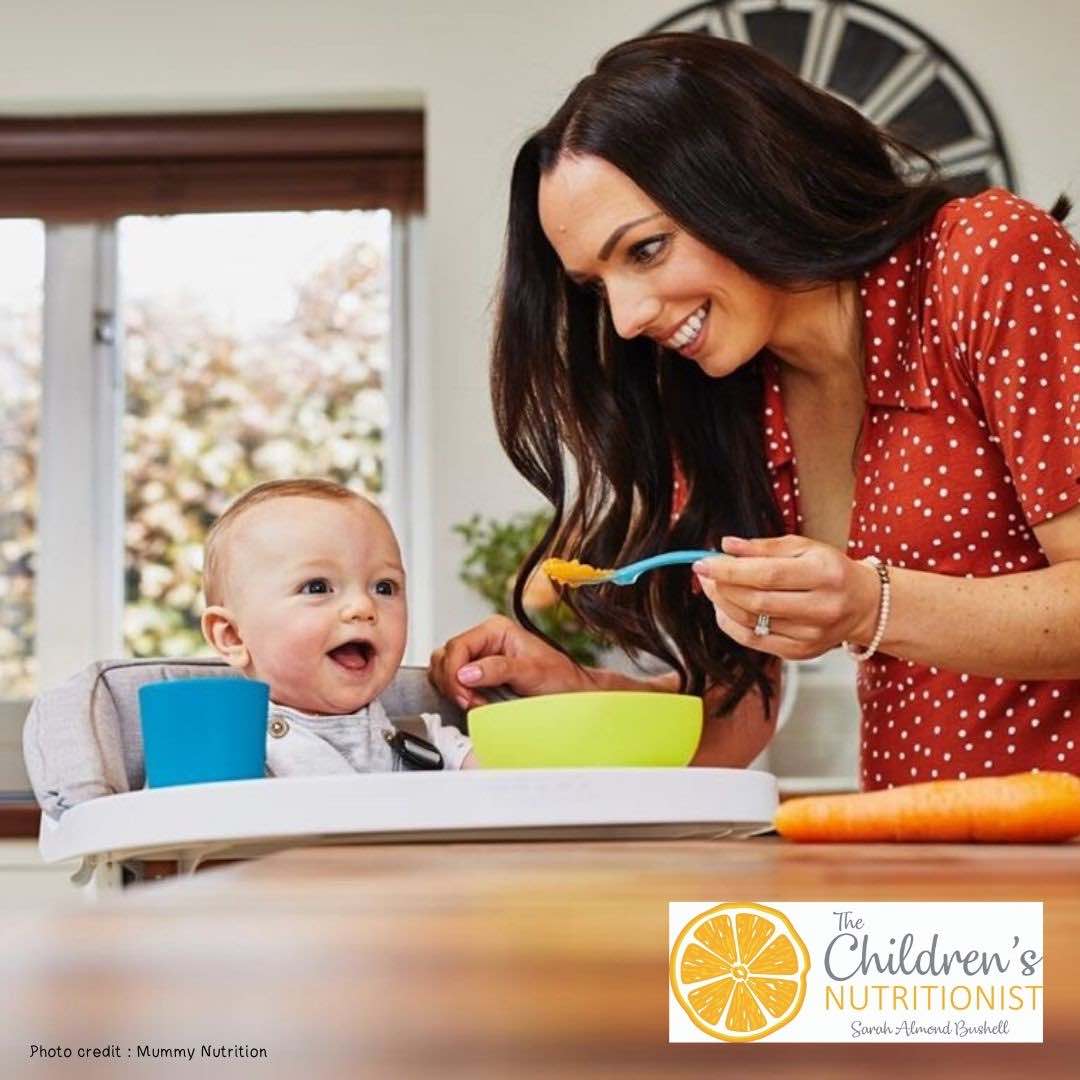
Looking for a meal plan with portion sizes to start feeding your baby solids? We’ve got it covered with examples from 6-12 months.
In part one of this series, we broke down some of the basic guidelines for you to follow when introducing solid foods to provide your baby with good nutrition. Now it’s time to take a closer look at the ballpark amounts and variety of foods for feeding baby solids and helping your infant reach her full health potential!
Tips for feeding baby solids
It’s best to offer your baby a variety of foods to switch things up so you don’t get bored – remember it’s easiest if you cook for family and include those foods in a modified form for your baby! Aim for varying textures depending on your baby’s ability to chew. When it comes to fruits and vegetables, help them eat the rainbow plus black, brown and white – think black beans, brown figs, and white bananas. By offering a variety of colors you’re ensuring your child gets all the nutrients and phytonutrients she needs for protection from viruses, bacteria, and disease. Below we have some ideas from the main food groups to get you started!
Common foods and textures for age 6-8 months (1,2)
Carbohydrates:
- Vegetables: cooked and pureed sweet potato, corn, or dark green vegetables like spinach (great source of iron!)
- Fruit: mashed avocado or banana, applesauce
- Grains/cereal: infant cereal mixed with breast milk or formula
Protein:
- Meat/fish/eggs: cooked and pureed chicken, turkey, beef (great source of iron!), lamb, salmon, tuna, white fish (avoid predatory fish such as shark and swordfish due to heavy metals); well-cooked scrambled eggs
- Legumes: cooked, strained and mashed black beans; mashed tofu
Fat:
- Legumes/nuts/oils: peanut butter or other nut or seed butter mixed with water, olive oil (use to cook tofu, meat, poultry, and fish)
*Quick Reminder: Remember that we don’t want to introduce any dairy until 8 months and wait until 12 months to introduce milk.
Common foods and textures for age 8 – 12 months
Carbohydrates:
- Vegetables: cooked vegetables cut into small pieces, such as sweet potato, cauliflower, squash and green beans; corn
- Fruits: diced (or mashed) pieces of banana, nectarines, kiwi, plum, pears, or blackberries
- Grains/cereal: small pieces of whole grain crackers or cereal, whole grain pasta, and bread, brown rice, quinoa
Protein:
- Meat/fish/eggs: chopped and ground chicken, turkey, beef, lamb, salmon, tuna, or other non-predatory fish; well-cooked scrambled eggs
- Legumes: whole cooked beans, legume pasta (we love green lentil pasta), small cut pieces of tofu; small pieces of bean or lentil pasta
- Dairy: cheese from pasteurized milk in soft textures and or whole fat yogurt. Starting at 12 months, whole fat milk or whole fat kefir – we love whole milk kefir as a baby’s first dairy as it helps build a healthy gut!
Fat:
- Oils used to cook meats, poultry, fish, tofu, etc., fat from nuts and seed butter
- Fat from dairy and animal protein
Your goal should be to offer foods from these food groups. Below you’ll find a guideline for serving sizes and an example of a feeding schedule for your baby as she proceeds through the introduction to solids phase.
Feeding baby solids – 6-8-months-old
Here are the recommendations for a day for a 6-8-month-old:
Portion Examples (3)
- 24-32 oz per day of breastmilk/formula
- Baby cereal: 4-8 Tbsp
- Vegetables: 4-8 Tbsp
- Fruit: 4-8 Tbsp
- Protein:1-6 Tbsp
- Water: 4-8 oz
Here is a sample day of eating (remember to start slowly and gradually increase based on babies’ cues):
- Bottle: 6-8 oz
- Breakfast: 2-4 Tbsp Baby cereal (mixed with breastmilk/formula) + 2-4 Tbsp fruit +1-3 Tbsp protein + 2-4 oz water
- Bottle: 6-8 oz
- Bottle: 6-8 oz
- Snack: 2-4 Tbsp Baby cereal mixed with breastmilk/formula + 2-4 Tbsp fruit/veg
- Dinner: 1-3 Tbsp protein +2-4 Tbsp Veg + 2-4 Tbsp fruit + 2-4 oz water
- Bottle: 6-8 oz
Feeding baby solids – 8-12-months-old
Here are the recommendations for a day for an 8-12-month-old:
Portion Examples (3)
- 24-32 oz per day of breastmilk/formula (at 10 months, breastmilk/formula intake can decrease to 18-24 oz as you build more solids into your baby’s diet)
- Baby cereal: 4-8 Tbsp
- Other grains: ¼ – ½ cup, 2x/day
- Veg: ¼ – ½ cup, 2-3x/day
- Fruit: ¼ – ½ cup, 2-3x/day
- Dairy: ¼ cup, 1-2x/day
- Protein: ¼ cup, 1-2x/day
Here is a sample day of eating (as solid food intake increases, breastmilk/formula intake may decrease):
- Bottle: 6 oz
- Breakfast: 4-8 Tbsp Baby cereal (mixed with breastmilk/formula) + ¼ – ½ cup fruit + ¼ cup dairy
- Bottle: 4-6 oz
- Lunch: ¼ – ½ cup grains + ¼ cup vegetables + ¼ cup protein + ¼ cup fruit
- Bottle: 4-6 oz
- Dinner: ¼ – ½ cup grains + ¼ cup vegetables + ¼ cup protein + ¼ cup dairy + ¼ cup fruit
- Bottle: 6 oz
Remember to keep an eye out for any allergic reactions when introducing new foods. You should also be in tune with your baby’s stool patterns. Download our free e-book, The Scoop on Poop, to become a poop pro and make sure your baby is as healthy as can be!
Looking for more ideas as your baby passes the one year mark? Read our other quick tips and meal ideas for toddlers & 1-year-olds.
Baby Nutrition & Baby-Led Weaning Course Recommendation
If you’re interested in learning more about feeding your baby solids and baby-led weaning, Registered Dietitian Sarah Almond Bushell offers a fantastic course. She’ll lead you through the minefield of information and further address questions like “When do I start?”, “Is baby-led weaning or purees best?”, and “How can I prevent choking?”. For more information and support check out The Children’s Nutritionist Baby Nutrition & Weaning Course*.
*If you purchase the course through our link we’ll receive a percentage of the sale at no extra cost to you.













